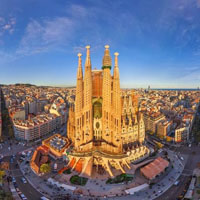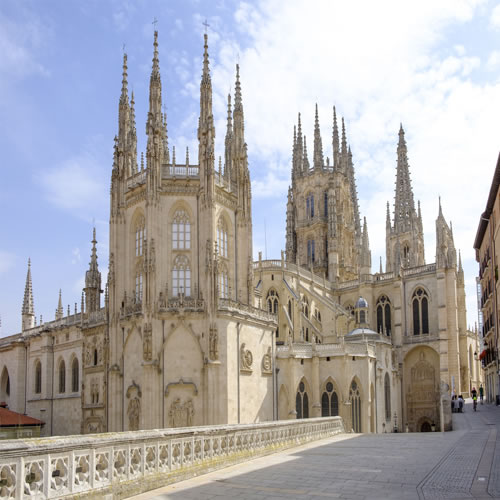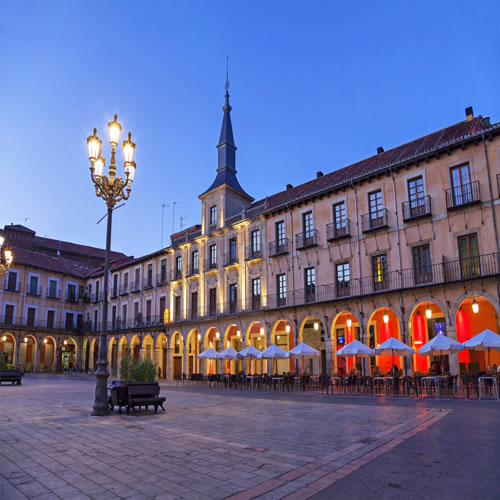The Way of Saint James (Self Drive)
❮The Way of Saint James (Self Drive)
Photos
This 10 night sample itinerary includes:
- Hotel for 2 nights in Madrid
- Rental Car for 9 days
- Hotel for 1 night in Pamplona
- Hotel for 1 night in Logrono
- Hotel for 1 night in Burgos
- Hotel for 2 nights in Leon
- Hotel for 1 night in Lugo
- Hotel for 2 nights in Santiago de Compostela
Driving Time
Madrid - Pamplona: 4 hrs. 20 mins. approx.
Pamplona - Logrono: 1 hr. approx.
Logrono - Burgos: 1 hr. 30 mins. approx.
Burgos - Leon: 1 hr. 45 mins. approx.
Leon - Lugo: 2 hrs. 20 mins. approx.
Lugo - Santiago de Compostela: 1 hr. 25 mins. approx.
Focus your visit to Spain following the steps of the pilgrims on the Way to Santiago. Visit Madrid, Pamplona, Logrono, Burgos, Leon, Lugo and Santiago de Compostela (historically pilgrims would have made the long walk to Santiago de Compostela for religious reasons. It is an important symbol of Spanish and European society, based on it's cultural and historical significance to the pilgrimage route). Connect these destinations with a Rental Car.
What Makes Tripmasters Vacation Packages Different?
Unique, fully custom approach to vacation planning
Choose your preferred flight cabin class
Select up to 14 nights in each city during your stay
Pick from a wide selection of accommodation types (hotels, apartments, B&Bs, Guesthouses, and more)
Add transfers, activities and experiences, and more services to enhance your vacation
Live phone and chat support

Flexible Itinerary
-
Madrid
 Day 1Arrive to Madrid
Day 1Arrive to Madrid
Overnight in MadridDay 2Overnight in MadridDay 3Departing from Madrid
Transportation to next city by: By Car -
Pamplona
 Day 3Arrive to Pamplona
Day 3Arrive to Pamplona
Overnight in PamplonaDay 4Departing from Pamplona
Transportation to next city by: Regional Air -
Logrono
 Day 4Arrive to Logrono
Day 4Arrive to Logrono
Overnight in LogronoDay 5Departing from Logrono
Transportation to next city by: Regional Air -
Burgos
 Day 5Arrive to Burgos
Day 5Arrive to Burgos
Overnight in BurgosDay 6Departing from Burgos
Transportation to next city by: Regional Air -
Leon
 Day 6Arrive to Leon
Day 6Arrive to Leon
Overnight in LeonDay 7Overnight in LeonDay 8Departing from Leon
Transportation to next city by: Regional Air -
Lugo
 Day 8Arrive to Lugo
Day 8Arrive to Lugo
Overnight in LugoDay 9Departing from Lugo
Transportation to next city by: Regional Air -
Santiago de Compostela
 Day 9Arrive to Santiago de Compostela
Day 9Arrive to Santiago de Compostela
Overnight in Santiago de CompostelaDay 10Overnight in Santiago de CompostelaDay 11Departing from Santiago de Compostela

Spain
Spain is one of the most popular countries in the world for tourists, and the experiences you can have while on vacation here can be just as varied as you are. The best way to experience Spanish life today is to visit one of its largest cities, such as Madrid, the country`s capital; Barcelona, its second city; and provincial capitals such as Seville and Valencia. Andalucia, the epicenter of Moorish rule in Spain, is known for its beautiful landmarks such as the UNESCO World Heritage Site, the Alhambra. The north of the country features such varying experiences as Catholic pilgrimages in Galicia, skiing in the Pyrenees, and immersing yourself in the culture of the gorgeous Basque Country. For beach vacations, Spain is tops, from the Costa del Sol to the Balearic islands of Ibiza and Mallorca to the Canary Islands.
Customer Reviews
Share your thoughts with other travelers
Write a ReviewTrip Summary
-
Madrid

In the last few years, Madrid has gained the reputation of being one of Europe's most active and attractive cities for its nightlife and cultural activities. Capital of Spain since 1562, Madrid's museums host, among others, Dalis, Miros and Picasso's Guernica. Madrid is a city of great contrasts: the Old City, the Madrid of the Hapsburgs, the Royal Palace, the Puerta de Alcala, the Retiro Park. At night, the city changes gears with its famous Madrid nightlife. The city's endless energy is hard to resist, and its sociable style invites you to jump right in.
Visit Palacio Real, Plaza Mayor, Prado Museum, Puerta del Sol, Puerta de Alcala, Plaza de Cibeles, Gran Via, Madrid Cathedral, Thyssen-Bornemisza and Reina Sofia Museums and so much more! -
Pamplona

Ernest Hemingway put Pamplona on the map by describing the famed running of the bulls. One can see the encierros (bull running) during Fiesta de San Fermín, usually between July 6 and July 14. The non-stop party atmosphere is spiced up by fireworks, Basque flute concerts, and wine. To get a hold of a bed, one must reserve a hotel one year in advance or stay in a neighboring town. Once a fortified city and the capital of the ancient kingdom of Navarre, Pamplona is more than one-event town.
Explore the Citadel of Pamplona, Plaza de Toros de Pamplona, Castle Square, Jardines de la Taconera, Pamplona Cathedral, Museum of Navarra, and more -
Logrono

This northern Spanish city gained some autonomy since the 12th century - as part of the Castile region and today is the capital of La Rioja region. The visitor will enjoy the local hospitality, the taste of the Rioja wine and relaxing walks in one of the numerous parks. You may admire here the "hell of Espolón", the modern Town Hall in Town Square and the Round Cathedral. If you happen to be here on Christmas time, don't miss the life size reconstruction of the biblical scene in Town Square.
Visit the Museo de La Rioja, Calle Laurel, Iglesia de Santiago el Real, Concatedral de Santa Maria de la Redonda, Church of San Bartolome, and more! -
Burgos

Burgos is a significant Northern Spanish touristic destination, hosting an impressive collection of ecclesiastical monuments. Most of them reflect the Gothic style, starting with the Cathedral - similar to the French cathedral of Bourges - and the monasteries of Las Huelgas and Miraflores. Also interesting to see are the El Rey hospital, once destined to the pilgrims traveling to Santiago, and the vestiges of the old fortress walls, with the famous arches of Santa Maria and Fernán González.
Visit Monasterio de las Huelgas, Camino del Cid, Burgos Cathedral, Arco de Santa Maria, Museum of Human Evolution, and more. -
Leon

The capital of the north-western Spanish province of León proposes impressive buildings in various architectural styles. The famous gothic Cathedral hosts the Royal Pantheon and empresses by its stained glassed windows. You can admire the Romanesque paintings of Basilica de San Isidoro and early Gaudian architecture of Casa de Botines. You're invited to visit the modernist MUSAC - Museum of Contemporary Art or enjoy one of the famous "fiestas", taking place at the Barrio Humedo or Plaza del Grano.
Explore The Museo de Arte Contemporaneo de Castilla y Leon, Convento de San Marcos, Museo de San Isidoro, Basilica of San Isidoro, Catedral de Leon, and more! -
Lugo

Lugo lays claim to be Galicia`s oldest and most historic provincial capital. Its documented history dates back to 14 BC and it was originally called "Lucus Augusti". The city is famous for its Roman Wall, built in the late third century (about 260 AD) and remains structurally complete today. Lugo also benefits from natural thermal springs and the early Roman settlers made good use of this pre-heated water by creating a city spa complex. Part of this spa still remains (with modern additions) and it is called the "Barrio del Puente" and is open to visitors. Lugo has spectacular scenery, a history and architectural heritage that spans from the Celts and Romans to the Neoclassical and Gothic, plus a culture and cuisine that is typical of the region.
Explore Parque do Miño, Parque de Rosalia de Castro, Muralla Romana de Lugo, Lugo Cathedral, Casa dos Mosaicos, and so much more! -
Santiago de Compostela

Located in the heart of Galicia, Santiago de Compostela is the third-largest holy city of the Christian world. Medieval pilgrims, rich and poor alike, made this town famous by traveling from all over Europe to visit the shrine of apostle St James, whose remains are said to be buried in the city's cathedral. The city is a university town as well as a marketplace for Galician farmers. In addition, it is one of the most romantic and historic cities in Spain.
Visit The City of Culture of Galicia, Museo del Pueblo Gallego, Monastery of San Martino Pinario, Praza do Obradoiro, Cathedral of Santiago de Compostela, Alameda Park, and more.
Visit Palacio Real, Plaza Mayor, Prado Museum, Puerta del Sol, Puerta de Alcala, Plaza de Cibeles, Gran Via, Madrid Cathedral, Thyssen-Bornemisza and Reina Sofia Museums and so much more!
Explore the Citadel of Pamplona, Plaza de Toros de Pamplona, Castle Square, Jardines de la Taconera, Pamplona Cathedral, Museum of Navarra, and more
Visit the Museo de La Rioja, Calle Laurel, Iglesia de Santiago el Real, Concatedral de Santa Maria de la Redonda, Church of San Bartolome, and more!
Visit Monasterio de las Huelgas, Camino del Cid, Burgos Cathedral, Arco de Santa Maria, Museum of Human Evolution, and more.
Explore The Museo de Arte Contemporaneo de Castilla y Leon, Convento de San Marcos, Museo de San Isidoro, Basilica of San Isidoro, Catedral de Leon, and more!
Explore Parque do Miño, Parque de Rosalia de Castro, Muralla Romana de Lugo, Lugo Cathedral, Casa dos Mosaicos, and so much more!
Visit The City of Culture of Galicia, Museo del Pueblo Gallego, Monastery of San Martino Pinario, Praza do Obradoiro, Cathedral of Santiago de Compostela, Alameda Park, and more.




